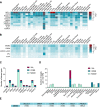Clinical considerations for the design of PROTACs in cancer
- PMID: 35249548
- PMCID: PMC8900451
- DOI: 10.1186/s12943-022-01535-7
Clinical considerations for the design of PROTACs in cancer
Abstract
Degradation of targeted proteins using proteolysis targeting chimeras (PROTACs) has gained momentum. A PROTAC is a bifunctional molecule that consists of three parts: a ligand that interacts with the protein to be degraded, another ligand that binds to an E3 ubiquitin ligase and a linker that connects both. Identification of the right proteins as targets to be degraded and a ligase that is highly expressed in tumors compare with normal tissue is mandatory, as can augment efficacy reducing toxicity. In this article we review the current development stage of PROTACs in cancer to categorize the best PROTAC construction. Targets including BCL2, CDK4 and MCL1 were highly expressed in all tumors; MCL1 was significantly increased in breast cancer and lung adenocarcinoma and CDK4 in colon adenocarcinoma. Degradation of CDK9, AURKA or PLK1, followed by BCL2, MCL1, PTPN11, BRD4, PTK2, showed a high dependency. Most ligases evaluated were not highly present in tumors except for MDM2 in breast, lung, prostate and gastric cancer. In non-transformed tissue MDM2 was the most abundant ligase, followed by cIAP and CRBN, and those with low expression included XIAP and VHL. MDM2 ligase coupled with inhibitors of the targets BCL2, BRD4, CDK9, PLK1 and MCL1 in stomach tumor, and MDM2 with PIK3C3 inhibitors in breast cancer, seems to be the best therapeutic strategy. Our results suggest potential options for the design of PROTACS in specific medical indications.
Keywords: Clinical approach; New therapies; PROTAC; Protein of interest.
© 2022. The Author(s).
Conflict of interest statement
A.O. is currently an employee of Symphogen, Copengahen, Denmark. No conflict of interest to declare in relation to this work.
Figures




Similar articles
-
Hijacking the MDM2 E3 Ligase with Novel BRD4-Targeting Proteolysis-Targeting Chimeras in Pancreatic Cancer Cells.Chembiochem. 2025 Jul 11;26(13):e202500133. doi: 10.1002/cbic.202500133. Epub 2025 Jun 23. Chembiochem. 2025. PMID: 40317844 Free PMC article.
-
Development of versatile solid-phase methods for syntheses of PROTACs with diverse E3 ligands.Bioorg Med Chem. 2023 May 15;86:117293. doi: 10.1016/j.bmc.2023.117293. Epub 2023 Apr 25. Bioorg Med Chem. 2023. PMID: 37126968
-
Discovery of E3 Ligase Ligands for Target Protein Degradation.Molecules. 2022 Oct 2;27(19):6515. doi: 10.3390/molecules27196515. Molecules. 2022. PMID: 36235052 Free PMC article. Review.
-
In situ albumin-binding and esterase-specifically cleaved BRD4-degrading PROTAC for targeted cancer therapy.Biomaterials. 2023 Apr;295:122038. doi: 10.1016/j.biomaterials.2023.122038. Epub 2023 Feb 7. Biomaterials. 2023. PMID: 36787659
-
Proteolysis-targeting chimeras (PROTACs) in cancer therapy.Mol Cancer. 2022 Apr 11;21(1):99. doi: 10.1186/s12943-021-01434-3. Mol Cancer. 2022. PMID: 35410300 Free PMC article. Review.
Cited by
-
BET Bromodomain Inhibitors: Novel Design Strategies and Therapeutic Applications.Molecules. 2023 Mar 29;28(7):3043. doi: 10.3390/molecules28073043. Molecules. 2023. PMID: 37049806 Free PMC article. Review.
-
PROTAC: Harnessing Targeted Chimeras for Selective BCL-2 Degradation in Cancer Treatment.ACS Med Chem Lett. 2023 Apr 13;14(5):541-542. doi: 10.1021/acsmedchemlett.3c00113. eCollection 2023 May 11. ACS Med Chem Lett. 2023. PMID: 37197463 Free PMC article.
-
Antiviral nanomedicine: Advantages, mechanisms and advanced therapies.Bioact Mater. 2025 Jun 5;52:92-122. doi: 10.1016/j.bioactmat.2025.05.030. eCollection 2025 Oct. Bioact Mater. 2025. PMID: 40530413 Free PMC article. Review.
-
Potent and Selective BCL-XL Inhibitors and PROTAC Compounds as Potential Cancer Treatment and Immunotherapy.ACS Med Chem Lett. 2023 May 16;14(6):702-704. doi: 10.1021/acsmedchemlett.3c00181. eCollection 2023 Jun 8. ACS Med Chem Lett. 2023. PMID: 37312850 Free PMC article.
-
Antiviral PROTACs: Opportunity borne with challenge.Cell Insight. 2023 Mar 27;2(3):100092. doi: 10.1016/j.cellin.2023.100092. eCollection 2023 Jun. Cell Insight. 2023. PMID: 37398636 Free PMC article. Review.
References
Publication types
MeSH terms
Substances
LinkOut - more resources
Full Text Sources
Medical
Research Materials
Miscellaneous

